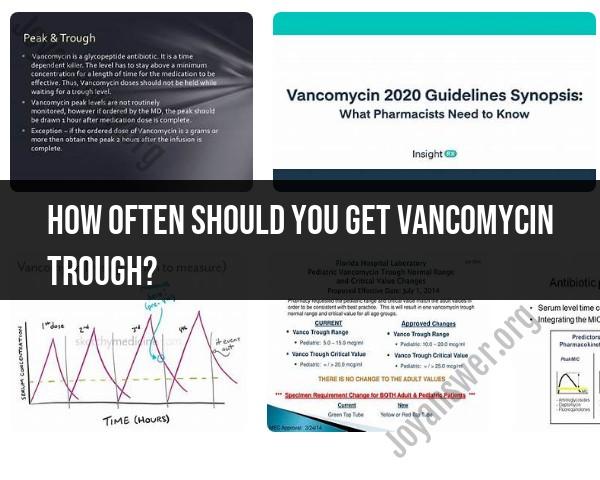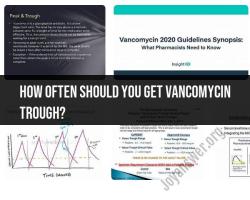How often should you get vancomycin trough?
The frequency of vancomycin trough level monitoring, which measures the concentration of vancomycin in the bloodstream, can vary based on several factors:
Clinical Situation: The frequency of monitoring may differ depending on the patient's condition, such as whether they have normal renal function or if they have impaired kidney function.
Dosage Regimen: The dosing regimen of vancomycin, whether it's a standard dosing schedule or adjusted based on therapeutic drug monitoring (TDM), influences the frequency of trough level measurements.
Patient-specific Factors: Individual patient factors, including age, weight, renal function, and the presence of other medical conditions, can impact the frequency of monitoring.
In general, vancomycin trough levels are commonly monitored:
- Initially: Trough levels are often checked after the fourth dose in order to evaluate the drug's steady-state concentration. This initial check helps in adjusting the dosage if necessary.
- During Therapy: For patients on a stable dosing regimen, trough levels are monitored periodically to ensure therapeutic levels are maintained and to prevent toxicity. Frequency may range from once every 3 to 7 days, depending on the clinical situation.
It's crucial to follow the recommendations provided by healthcare professionals, including physicians, pharmacists, or infectious disease specialists, regarding the specific monitoring schedule for vancomycin trough levels. These experts assess the patient's individual needs and adjust the monitoring frequency based on the patient's response to treatment, potential side effects, and the desired therapeutic range of vancomycin in the bloodstream to effectively treat the infection while minimizing risks of toxicity.
The recommended frequency for measuring vancomycin trough levels depends on several factors, including the individual patient's condition, their renal function, and the specific vancomycin dosing regimen. However, in general, vancomycin trough levels are typically monitored every 24-48 hours, particularly during the initial phase of therapy or when there are concerns about achieving or maintaining therapeutic drug concentrations.
Factors Influencing Vancomycin Trough Level Monitoring Frequency:
Patient Condition: Patients with severe infections, renal impairment, or other comorbidities may require more frequent trough level monitoring to ensure adequate drug concentrations and avoid potential toxicity.
Renal Function: Vancomycin is primarily eliminated by the kidneys, and impaired renal function can significantly slow down drug clearance. Patients with reduced kidney function may require more frequent trough level monitoring to adjust dosing and prevent accumulation of the drug.
Vancomycin Dosing Regimen: Different vancomycin dosing regimens may require different trough level monitoring frequencies. For instance, patients receiving continuous infusion therapy may require less frequent monitoring compared to those receiving intermittent bolus dosing.
General Guidelines for Vancomycin Trough Level Monitoring:
Initial Phase of Therapy: Trough levels are typically monitored every 24-48 hours during the initial phase of therapy to ensure that the drug is reaching therapeutic concentrations.
Stable Therapy: Once therapeutic levels are achieved, trough level monitoring may be reduced to every 48-72 hours for stable patients with normal renal function.
Adjustments to Dosing or Renal Function: If there are any changes to the vancomycin dosing regimen or the patient's renal function, trough level monitoring should be increased to ensure that drug concentrations remain within the therapeutic range.
Potential Toxicity Concerns: If there are concerns about potential vancomycin toxicity, trough level monitoring may be increased to prevent adverse effects.
It is important to consult with a healthcare provider to determine the appropriate frequency of vancomycin trough level monitoring for each individual patient. Regular monitoring of vancomycin trough levels helps ensure optimal drug concentrations, minimize the risk of toxicity, and achieve successful treatment outcomes.





